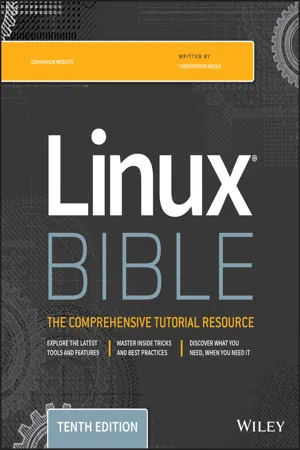Linux Bible
About this book
The industry favorite Linux guide
Linux Bible, 10th Edition is the ultimate hands-on Linux user guide, whether you're a true beginner or a more advanced user navigating recent changes. this updated tenth edition covers the latest versions of Red Hat Enterprise Linux (RHEL 8), Fedora 30, and Ubuntu 18.04 LTS. It includes information on cloud computing, with new guidance on containerization, Ansible automation, and Kubernetes and OpenShift. With a focus on RHEL 8, this new edition teaches techniques for managing storage, users, and security, while emphasizing simplified administrative techniques with Cockpit. Written by a Red Hat expert, this book provides the clear explanations and step-by-step instructions that demystify Linux and bring the new features seamlessly into your workflow.
This useful guide assumes a base of little or no Linux knowledge, and takes you step by step through what you need to know to get the job done.
- Get Linux up and running quickly
- Master basic operations and tackle more advanced tasks
- Get up to date on the recent changes to Linux server system management
- Bring Linux to the cloud using Openstack and Cloudforms
- Simplified Linux administration through the Cockpit Web Interface
- Automated Linux Deployment with Ansible
- Learn to navigate Linux with Amazon (AWS), Google (GCE), and Microsofr Azure Cloud services
Linux Bible, 10th Edition is the one resource you need, and provides the hands-on training that gets you on track in a flash.
Frequently asked questions
- Essential is ideal for learners and professionals who enjoy exploring a wide range of subjects. Access the Essential Library with 800,000+ trusted titles and best-sellers across business, personal growth, and the humanities. Includes unlimited reading time and Standard Read Aloud voice.
- Complete: Perfect for advanced learners and researchers needing full, unrestricted access. Unlock 1.4M+ books across hundreds of subjects, including academic and specialized titles. The Complete Plan also includes advanced features like Premium Read Aloud and Research Assistant.
Please note we cannot support devices running on iOS 13 and Android 7 or earlier. Learn more about using the app.
Information
Part I
Getting Started
IN THIS PART
- Chapter 1 Starting with Linux
- Chapter 2 Creating the Perfect Linux Desktop
CHAPTER 1
Starting with Linux
IN THIS CHAPTER
- Learning what Linux is
- Learning where Linux came from
- Choosing Linux distributions
- Exploring professional opportunities with Linux
- Becoming certified in Linux
Understanding What Linux Is
- Detecting and preparing hardware: When the Linux system boots up (when you turn on your computer), it looks at the components on your computer (CPU, hard drive, network cards, and so on) and loads the software (drivers and modules) needed to access those particular hardware devices.
- Managing processes: The operating system must keep track of multiple processes running at the same time and decide which have access to the CPU and when. The system also must offer ways of starting, stopping, and changing the status of processes.
- Managing memory: RAM and swap space (extended memory) must be allocated to applications as they need memory. The operating system decides how requests for memory are handled.
- Providing user interfaces: An operating system must provide ways of accessing the system. The first Linux systems were accessed from a command-line interpreter called a shell. Today, graphical desktop interfaces are commonly available as well.
- Controlling filesystems: Filesystem structures are built into the operating system (or loaded as modules). The operating system controls ownership and access to the files and directories (folders) that the filesystems contain.
- Providing user access and authentication: Creating user accounts and allowing boundaries to be set between users is a basic feature of Linux. Separate user and group accounts enable users to control their own files and processes.
- Offering administrative utilities: In Linux, hundreds (perhaps thousands) of commands and graphical windows are available to do such things as add users, manage disks, monitor the network, install software, and generally secure and manage your computer. Web UI tools, such as Cockpit, have lowered the bar for doing complex administrative tasks.
- Starting up services: To use printers, handle log messages, and provide a variety of system and network services, processes called daemon processes run in the background, waiting for requests to come in. Many types of services run in Linux. Linux provides different ways of starting and stopping these services. In other words, while Linux includes web browsers to view web pages, it can also be the computer that serves up web pages to others. Popular server features include web, mail, database, printer, file, DNS, and DHCP servers.
- Programming tools: A wide variety of programming utilities for creating applications and libraries for implementing specialty interfaces are available with Linux.
- Clustering: Linux can be configured to work in clusters so that multiple systems can appear as one system to the outside world. Services can be configured to pass back and forth between cluster nodes while appearing to those using the services that they are running without interruption.
- V...
Table of contents
- Cover
- Table of Contents
- Introduction
- Part I: Getting Started
- Part II: Becoming a Linux Power User
- Part III: Becoming a Linux System Administrator
- Part IV: Becoming a Linux Server Administrator
- Part V: Learning Linux Security Techniques
- Part VI: Engaging with Cloud Computing
- Part VII: Appendixes
- Index
- End User License Agreement
